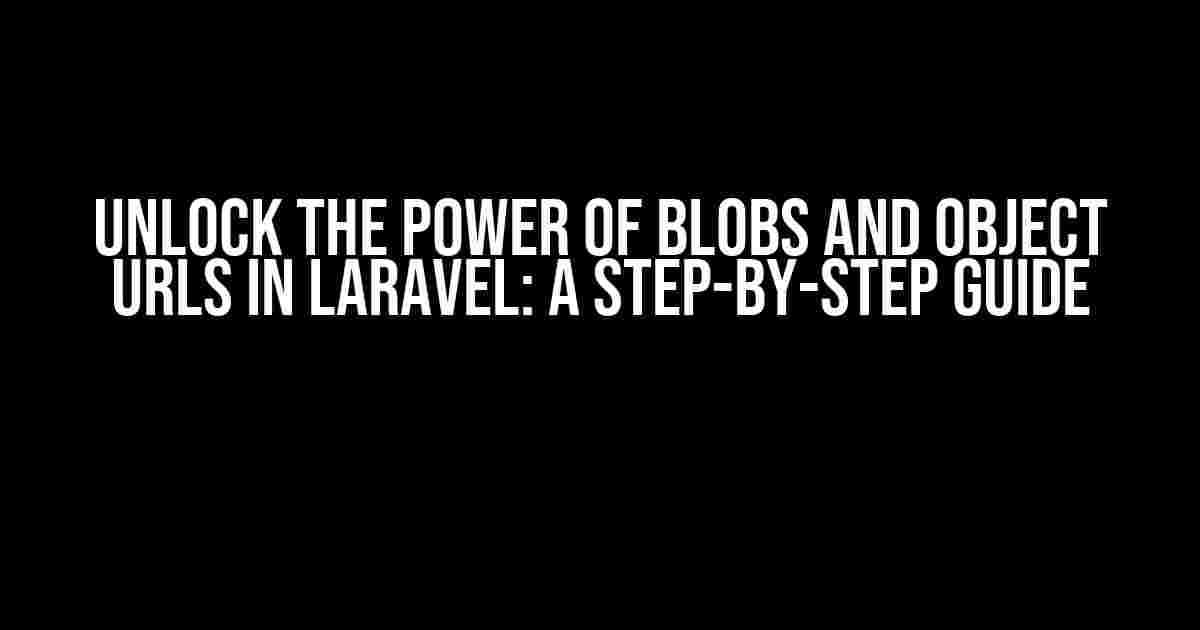Are you tired of dealing with file uploads in Laravel and wondering how to leverage the power of blobs and object URLs? Look no further! In this comprehensive guide, we’ll take you on a journey to explore the world of blobs and object URLs, and show you how to make the most out of them in your Laravel application.
What are Blobs and Object URLs?
Blobs, short for Binary Large OBjects, are a type of data storage used to hold large amounts of binary data, such as images, videos, and audio files. In the context of Laravel, blobs are used to store files in a database. Object URLs, on the other hand, are a way to generate a URL that points to a specific blob, allowing you to access the file without having to download it.
Why Use Blobs and Object URLs?
So, why would you want to use blobs and object URLs in your Laravel application? Here are some benefits:
- Secure file storage: Blobs provide a secure way to store sensitive files, as they are stored in a database rather than on the file system.
- Faster file access: Object URLs allow you to access files quickly and efficiently, without having to download the entire file.
- Efficient file management: Blobs and object URLs make it easy to manage files, including uploading, downloading, and deleting files.
Setting Up Blobs and Object URLs in Laravel
Now that we’ve covered the basics, let’s dive into setting up blobs and object URLs in Laravel.
Step 1: Install the Required Packages
To work with blobs and object URLs in Laravel, you’ll need to install the following packages:
composer require symfony/http-foundation
composer require league/flysystem-aws-s3-v3The first package, `symfony/http-foundation`, provides the necessary classes for working with HTTP requests and responses. The second package, `league/flysystem-aws-s3-v3`, provides an implementation of the Flysystem file system, which is used to interact with AWS S3.
Step 2: Configure Flysystem
Once you’ve installed the required packages, you’ll need to configure Flysystem. In your Laravel application, create a new file called `flysystem.php` in the `config` directory:
<?php
return [
'default' => 's3',
'disks' => [
's3' => [
'driver' => 's3',
'key' => env('AWS_ACCESS_KEY_ID'),
'secret' => env('AWS_SECRET_ACCESS_KEY'),
'bucket' => env('AWS_BUCKET'),
'region' => env('AWS_REGION'),
],
],
];
This configuration sets up Flysystem to use the `s3` driver, which interacts with AWS S3. You’ll need to set the environment variables `AWS_ACCESS_KEY_ID`, `AWS_SECRET_ACCESS_KEY`, `AWS_BUCKET`, and `AWS_REGION` in your `.env` file.
Creating a Blob in Laravel
Now that we’ve set up Flysystem, let’s create a blob in Laravel.
Step 1: Create a New File
First, create a new file in your Laravel application using the following code:
<?php
namespace App\Http\Controllers;
use Illuminate\Http\Request;
use Illuminate\Support\Facades\Storage;
class BlobController extends Controller
{
public function createBlob(Request $request)
{
$file = $request->file('file');
$blob = Storage::disk('s3')->putFile('/blobs', $file);
return response()->json(['blob' => $blob]);
}
}
This code creates a new file using the `putFile` method, which uploads the file to AWS S3 and returns the blob URL.
Step 2: Generate an Object URL
Once you’ve created the blob, you can generate an object URL using the following code:
<?php
namespace App\Http\Controllers;
use Illuminate\Http\Request;
use Illuminate\Support\Facades\Storage;
class BlobController extends Controller
{
public function getObjectUrl(Request $request)
{
$blob = 'path/to/blob';
$url = Storage::disk('s3')->temporaryUrl($blob, now()->addMinutes(30));
return response()->json(['url' => $url]);
}
}
This code generates a temporary URL that points to the blob, which is valid for 30 minutes.
Using Blobs and Object URLs in Your Laravel Application
Now that we’ve covered the basics of creating blobs and object URLs, let’s explore how to use them in your Laravel application.
Uploading Files
To upload files using blobs, you can use the following code:
<form method="POST" action="/blobs" enctype="multipart/form-data">
@csrf
<input type="file" name="file">
<button type="submit">Upload</button>
</form>
This code creates a simple file upload form that sends a POST request to the `/blobs` route.
Downloading Files
To download files using object URLs, you can use the following code:
<a href="{{$objectUrl}}" download>Download File</a>
This code generates a link that points to the object URL, allowing the user to download the file.
Tips and Tricks
Here are some tips and tricks to keep in mind when working with blobs and object URLs in Laravel:
- Make sure to set the correct permissions on your AWS S3 bucket to allow Flysystem to interact with it.
- Use the `temporaryUrl` method to generate a temporary URL that points to the blob, rather than the `url` method, which returns a permanent URL.
- Use the `Storage` facade to interact with Flysystem, rather than instantiating the Flysystem class directly.
Conclusion
In this article, we’ve covered the basics of creating blobs and object URLs in Laravel, as well as how to use them in your application. By following these steps, you can unlock the power of blobs and object URLs and take your file management to the next level.
| Keyword | Description |
|---|---|
| Blob | A type of data storage used to hold large amounts of binary data. |
| Object URL | A URL that points to a specific blob, allowing you to access the file without having to download it. |
| Flysystem | A file system abstraction layer that provides a unified interface for interacting with various file systems. |
| AWS S3 | A cloud-based object storage service offered by Amazon Web Services. |
We hope this article has been informative and helpful in your journey to mastering blobs and object URLs in Laravel. Happy coding!
Frequently Asked Question
Get ready to dive into the world of Laravel and discover the secrets of creating a blob and object URL!
What is a blob and object URL, and why do I need them in Laravel?
A blob (Binary Large OBject) is a collection of binary data stored as a single entity, while an object URL is a unique identifier for accessing that blob. In Laravel, you need them to store and retrieve files, images, or other binary data efficiently. By creating a blob and object URL, you can upload, download, and manipulate files securely and scalably.
How do I create a blob in Laravel?
To create a blob in Laravel, you can use the `Storage` facade and the `put` method. For example, `Storage::put(‘file.txt’, ‘Hello, World!’);` will create a blob with the contents of the string ‘Hello, World!’ and store it in the default storage disk. You can also use the `putFile` method to upload a file from a request.
How do I generate an object URL in Laravel?
To generate an object URL in Laravel, you can use the `Storage` facade and the `url` method. For example, `$objectUrl = Storage::url(‘file.txt’);` will generate a URL that points to the blob stored in the default storage disk. You can also use the `temporaryUrl` method to generate a temporary URL with an expiration time.
Can I use Amazon S3 to store my blobs and generate object URLs in Laravel?
Yes, you can use Amazon S3 to store your blobs and generate object URLs in Laravel. You need to configure the S3 storage disk in your Laravel project and update your `filesystems.php` configuration file. Then, you can use the `Storage` facade to interact with S3 and generate object URLs using the `url` or `temporaryUrl` methods.
What are some best practices for working with blobs and object URLs in Laravel?
Some best practices for working with blobs and object URLs in Laravel include using a consistent naming convention for your blobs, implementing proper error handling and logging, and using Laravel’s built-in caching mechanisms to improve performance. Additionally, consider using a queuing system like Laravel’s built-in Queue system to handle large file uploads and processing.





